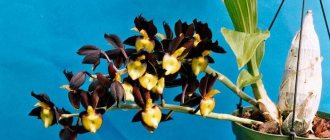How and how long do orchids bloom?
Different types of orchids bloom differently. For example, phalaenopsis flowers resemble butterflies in shape, and dendrobium flowers resemble miniature lilies. They also differ in the duration of flowering. When the appropriate conditions are created and proper care is taken, the flowering of phalaenopsis will be almost continuous. Dendrobium blooms seasonally, over several months. So, the orchid has faded, what to do next?
Possible problems with growing orchids
When growing an orchid, you may encounter some problems. They are mainly caused by improper plant care.
Let's look at some of them:
- Fungal diseases. They are provoked by excessive watering and high humidity in a room that is poorly ventilated and there is no access to fresh air to the flower.
- Yellowing of foliage and loss of color. This phenomenon occurs if the pot with the plant is moved to another place.
- Burns on leaves causes direct sunlight to hit the flower.
- If the orchid appears to be quite healthy, but does not produce color, then this indicates insufficient lighting or lack of necessary temperature changes.
- Slowing growth, as well as dried out or rotten roots, lack of color, the appearance of pests - all this often signals dry air. Of the pests, the orchid is often attacked by scale insects. This insect can be identified by a sticky coating and the appearance of brown plaques. At the initial stage of damage, it is enough to carefully clean the plant with a soap solution. If this does not help, use chemicals (for example, Actellik).
We recommend that you learn more about orchid pests and their control.
Before taking any measures after an orchid blooms, you should familiarize yourself with the features of its life cycle. In some species, repeat flowering can be achieved, while in others a period of dormancy may be necessary.
Caring for phalaenopsis after flowering
Towards the end of flowering, the phalaenopsis peduncle becomes covered with a waxy coating; usually, after this moment, new flowers no longer appear on it. After the flowers have completely fallen off, further actions largely depend on its condition.
If the flower stalk begins to dry out
After the orchid has finished blooming, you should not immediately start pruning it. You need to wait for a while and observe her condition. If during this time the peduncle turns brown and dries out, you can cut it off completely. It should be cut right to the base. Otherwise, the remaining stump will become a source of various infections and putrefactive diseases.
In some cases, the peduncle dries out only partially. In such a situation, it is best to hold off on pruning. Gradually, the dying arrow gives nutrients to the mother plant. If you cut it out too early, it will affect the overall condition of the orchid.
Another scenario for the development of events after the orchid has bloomed is when the upper part of the peduncle has dried up, and the dormant buds below begin to swell. In this case, the peduncle is carefully trimmed to living green tissue.
If the peduncle remains green
Beginning flower growers very often ask what to do after the orchid has faded, but the peduncle still remains green? In this case, there is no need to take any pruning action. Soon the plant will bloom again. But it should be borne in mind that in this case more careful care will be required. The absence of a rest period will significantly weaken the orchid, so it will need more intensive nutrition.
Basic rules of care
In most cases, after the orchid has bloomed, it begins a short period of rest. During this process, the plant needs to create the following conditions:
- daytime temperature is not higher than +25 °C, night temperature is within 16–18 °C;
- bright diffuse lighting;
- minimum humidity; spraying during this period should be completely abandoned.
But also during this period she should be given appropriate care:
- Watering is reduced to a minimum. Subject to the temperature conditions specified above, watering is carried out once every two weeks;
- Any feeding and fertilizing are completely excluded.
Subject to such conditions and care during the dormant period, the plant fully restores its strength. This usually takes no more than two months. Then watering gradually begins to increase, and the plant, when growth resumes, is transplanted into a fresh substrate.
Features of care during the rest period
Most often, at this time, flower care is carried out as usual, but the intensity of watering should be reduced and fertilizing should be stopped. Many types of orchids need to organize a pronounced period of rest, and it varies for different species. If for cattleyas it is enough to reduce watering, then dendrobiums and cymbidiums also need to lower the temperature to +10°C. But phalaenopsis does without wintering and if it is going to bloom again, then the temperature regime remains normal - at night not lower than +15°C, during the day + 22...+23°C.
Temperature fluctuations during the dormant period should usually be small - only 2–3°C. Then, after dormancy, they make more of them to stimulate flowering. In apartments, the desired temperature and its fluctuations are achieved naturally in the off-season, when the heating is not turned on. If the heating system has thermostats, then you can use them for the required differences. Sometimes, to achieve the required temperatures and their fluctuations, the plant is taken out onto the balcony.
Did you know? According to the flower horoscope, the orchid is the flower of people born between November 3 and November 12. Thanks to her influence, representatives of this sign are distinguished by mystery and mystery.
Caring for dendrobium after flowering
Dendrobium is another common orchid. Its flowering period occurs in late autumn and winter. Unlike phalaenopsis, it does not produce a separate peduncle. Therefore, after the orchid has bloomed, there are no questions about what to do with the arrow. At this moment, the dendrobium begins a period of active growth. It actively grows young pseudobulbs, which will subsequently develop their own root system. So, the dendrobium orchid has faded, what to do next?
Transfer
If the dendrobium was purchased quite recently and has just finished flowering, there is no need to replant it. If your plant has been growing for a number of years without changing the substrate, then it needs replanting. It should be started after the new pseudobulbs reach a size of at least 10 cm.
This will require a special substrate consisting of bark and sphagnum moss. You can purchase it at a specialized flower shop. A pot for growing dendrobium does not have to be transparent. The main thing is that it has enough drainage holes.
The transplant process itself is as follows:
- A layer of gravel is placed at the bottom of the new pot; it not only acts as a drainage layer, but also prevents it from tipping over.
- The largest pieces of bark are placed on top of the drainage.
- The orchid's root system is carefully placed on the bark.
- The remaining space between the roots is filled with finer bark.
- The top of the substrate is covered with a layer of moss.
Pruning pseudobulbs
Dendrobimum pseudobulbs bloom only once, but at the same time you can observe a repeated wave of flowering from dormant buds. The buds of this orchid are located along the entire length of the pseudobulb. Therefore, if only the crown bloomed for the first time, then when the appropriate conditions are created, flowering will also be observed on the lower part.
After the dendrobium orchid has bloomed, you should not immediately cut off the pseudobulbs for one more reason. For her, they are a kind of storage organ. Old pseudobulbs give their nutrients to young shoots.
They begin pruning only after the leaves have completely fallen off and withered. To do this, the bulbs are carefully cut out at the very base using a sharp knife or pruning shears.
Attention! The sections obtained during the cutting process must be treated with cinnamon powder or ground charcoal.
Watering
After the orchid has bloomed, it continues an active period of growth. At this moment, it needs abundant, timely watering. This can be done either by immersion or by pouring the substrate. Water for irrigation must be warm and pre-settled. In this case, the upper part of the substrate must dry out between waterings.
Feeding
During the period after flowering, the dendrobium continues to actively develop, and at this moment it needs to be fed. To do this, it is best to use specialized fertilizers for orchids. The average frequency of feeding should be no more than once every two weeks.
So we learned how to prune a faded orchid, and what to do in cases where the plant refuses to bloom again?
Various options for watering orchids
The effect of tropical humidification is achieved by various types of irrigation. The main thing is to maintain a balance: saturate the roots with moisture, but not allow them to rot.
Immersion in water
The bottom watering method is the most effective for orchids. David Hession, a well-known author of books on floriculture, considers this method preferable to others because it allows water to penetrate better into a dense substrate than watering from above.
To do this, use a large container with water suitable for irrigation. The pot is slowly lowered into water, otherwise the dry roots and substrate will push the plant out. When immersed, the water should not reach the growth point of the plant. It is enough to keep the pot in water for 10–15 minutes. You cannot leave it in water for a long time; swelling of the leaves may begin, which does not go away and cannot be treated; the leaf will have to be removed. Then the water is allowed to drain.
This method of watering is suitable for healthy plants. If there are a lot of flowers, then it is better to use this method for each pot separately. It’s safer this way: if one plant turns out to be sick, others will not become infected.
Humidification from pallets
Pots with orchids are placed in trays with high sides, then water is poured into it to a level of 1–2 cm. The roots will evenly absorb moisture as needed. Water is added once a week.
M. Khomutovsky studied the resistance of orchids to submersible watering and from bowls. Both methods were found to be acceptable. To avoid the spread of disease if a plant is sick, it is better to place each pot in a separate pot instead of pallets.
Shower for orchids
In warm weather, the plant can be washed once a month under the running shower in the bathroom, but only if it does not bloom. Make the water warm (38–42 °C) and the pressure low. Such “rain” will refresh the tropical flower and wash away the dust that prevents the leaves from breathing.
After your shower, leave it in the bathroom to drain off excess water. Remove water from the growing point and from the axils of the leaves with a soft cloth.
Root spraying
Sometimes orchids are grown in blocks without substrate. They are also moistened when the roots dry, but with a special method: a “fog” is created with a spray bottle - finely scattered droplets of water. The roots begin to turn green, saturated with moisture.
Watering with a watering can
For orchids, the simplest and most common method of watering is possible, as for all indoor plants. A thin stream of water is directed onto the substrate along the very edge. Soon the water will begin to flow into the holes of the pot at the bottom.
This type of watering has a drawback - not all roots have time to become saturated with moisture. There will be excess of it for the lower roots, which is why they rot.
Flower growers know that all plants require an individual approach, especially with watering. The exotic orchid differs in this little way. There are many ways to water it, so you can choose the appropriate one.
Original article: https://www.nur.kz/household/houseplants/1759947-kak-polivat-orhideu-posle-cvetenia/
How to make an orchid bloom again
In most cases, phalaenopsis and dendrobim bloom easily at home. But sometimes there may be no flowering for a whole series. The most likely and common of them are discussed below.
Lack of lighting and non-compliance with temperature conditions
All orchids come from the tropics, so they need bright lighting for normal development. With a lack of light, their growth processes slow down and the plants begin to experience stress. Its result can be either a lack of flowering or complete death.
With a lack of natural light. Especially in the autumn-winter period, it is recommended that orchids be equipped with lighting. To do this, you can purchase special photo lamps or use regular fluorescent lamps. The total length of daylight for orchids, even during the dormant period, should not be less than 12 hours.
Too high a temperature, especially during the dormant period, can also cause a lack of flowering. To avoid this, plants should be placed away from heating radiators, and in the summer they should be shaded from direct sunlight.
Lack or excess of nutrition
Another fairly common reason for the lack of flowering is nutritional errors. It should be borne in mind that excessive application of fertilizers is no less harmful than their lack. Orchids should be fed only during periods of intensive growth. Fertilizers should be diluted and used only in full accordance with the attached instructions. Fertilizing during the dormant period is strictly prohibited.
Pruning the peduncle of various plant species
One of the most popular types of orchids, Vanda attracts gardeners with its amazing flowers, which can be plain, variegated or with mosaic patterns. Vanda can bloom quickly at any time of the year for one and a half to two months. For a faded orchid, it is necessary to completely cut off the peduncle and reduce watering and spraying.
Faded arrows of Vanda orchids are pruned after flowering
Aganisia is also a common type of orchid. When kept at home, flowering lasts 10–14 days, mainly in summer. When the aganisia stops blooming, the shoot is cut off, and the plant itself, if necessary, is replanted and watering is reduced.
The arrow of the Aganisia orchid is immediately removed after flowering.
Another interesting type of orchid, dendrobium, has many varieties. Flowering occurs through pseudobulbs, which should not be removed after flowering, since the plant receives nutrients from them to form new flower stalks. Pseudobulbs can be trimmed after the leaves have completely dried and fallen off.
The Dendrobium orchid has pseudobulbs as flower stalks.
Cattleya attracts attention with large flowers with a subtle pleasant aroma. Thanks to the many arrows, it blooms for quite a long time. As soon as the first buds form, experts advise removing the new shoots that appear. This technique will allow the flowers to open, otherwise the plant will spend all its energy on growing shoots, but will no longer be able to bloom. Cattleya peduncles should be trimmed after complete drying.
The arrow of the Cattleya orchid is also removed after complete drying.
How to stimulate flowering?
You can stimulate re-blooming of orchids by creating stressful conditions. You can do this in the following ways:
- Severely limit watering. Sometimes, after complete drying, the plant begins to actively develop flower stalks. But moderation should be observed. Drying too much can lead to irreversible damage to the root system.
- Create a difference between day and night temperatures. In some cases, significantly lower night temperatures stimulate flowering. To do this, you can simply open the window over the plant at night.
Orchid flowering period
The flowering time of a crop depends on its type, growing conditions and care. Some varieties can bloom from 3 to 8 months. There are species that bloom all year round. For example, continuous flowering is characteristic of the Phalaenopsis variety. At home, an orchid can bloom from 3 to 10 years with regular breaks. If you do not properly care for a plant in a pot, the lifespan will be shortened.
Orchid in a pot
One flower blooms for 3-4 weeks. If you do not trim the peduncle after flowering has finished, it may bloom again after some time. To do this, the plant begins to be intensively fed and watered.
Note! Water the flower only with water at room temperature. If there is excess moisture, the plant not only drops its petals, but may also die.
Temperature for orchids in winter
Another important indicator that can affect the successful establishment of flower buds and the formation of buds in the future is temperature and lighting.
Figure 4. Strong temperature fluctuations can negatively affect the condition of leaves and roots
In winter and autumn, the optimal temperature indicators should be within +15 degrees at night and +23 during the day, while natural deviations from these indicators by 5-7 degrees are considered normal. If there is a strong deviation from these indicators, the leaves of the plant begin to change color and lose elasticity (Figure 4).
Note: If the room is too hot, you can open the window slightly. This will help not only stabilize the temperature, but also provide the plant with fresh air, which is also necessary for the development of the flower and the formation of buds, from which buds are subsequently formed.
Figure 5. For artificial lighting, it is better to buy a special phytolamp in advance.
In October, the intensity of the sun's rays decreases, so if you previously hid the flower from direct sunlight, now you can safely move it to the southern windowsill. But even in this case, natural light may not be enough for this tropical flower. In this case, you will have to use phytolamps, which should be turned on for 12 hours every day (Figure 5).
General information
The culture amazes with its diversity of varieties. Caring for orchids in winter is carried out taking into account the distribution of plants into the following groups:
- those that do not go into a dormant state (paphiopedilums (slippers), phalaenopsis, miltonia, vanda);
- with a weakly expressed state of dormancy (oncidiums, cattleyas, dendrobiums and laelia);
- with a pronounced state of dormancy (tunia, calantha, playone and several species of dendrobium).
For the first group, care actions in winter are slightly different from actions in warm seasons. For the second, watering and fertilizing are reduced. To care for species that go into a state of complete dormancy, it is worth following some rules.











